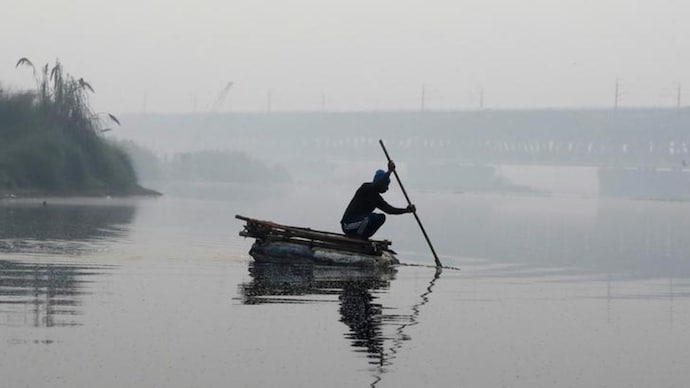Will recharging Yamuna floodplains end Delhi's water woes?
Small ponds will be made, and when Yamuna overflows during Monsoon, the overflowing water will fill these ponds. Water will then percolate down and it will spread leading to an increase in the water table of these areas.

In Short
- AAP in Delhi intends to initiate groundwater recharging this monsoon itself
- Due to some constraints, the work will be on an experimental basis given
- Arvind Kejriwal said that the project will solve Delhi's water crisis
Delhi government's ambitious project to recharge Yamuna floodplain gets cabinet nod.
Delhi Chief Minister Arvind Kejriwal said that the project will solve Delhi's water crisis and make the city future ready in terms of water conservation.
"In Delhi we keep reading that the water table is depleting fast. We want to end water shortage in Delhi," Arvind Kejriwal said.
Aaam Aadmi Party government in power in Delhi intends to initiate the groundwater recharging this monsoon itself, given the time constraint, this time this work will be on an experimental basis.
The project would only proceed full steam next year after the pilot sudy results are out.
"The result of the pilot study will help us form a clear idea about the success of this project, though the report of the project consultant and IIT [Indian Institutes of Technology] Delhi indicates that this project will be a big success, since the Yamuna has a vast floodplain and has a big potential for water conservation." Arvind Kejriwal said.
HOW WILL IT WORK?
Water will be conserved in stretches from Palla till Wazirabad on a completely eco-friendly basis.
No construction or use of cement will be involved and regular flow of Yamuna will not be touched at all.
Small ponds will be made, and when Yamuna overflows during Monsoon, the overflowing water will fill these ponds. Water will then percolate down and it will spread leading to an increase in the water table of these areas.
"The good thing in Delhi is the flow of water from Yamuna slope is towards the city and not the other way round, therefore conservation of rainwater is possible. Had the slope been towards Yamuna, then the rainwater would have flown towards the river. The project consultant has also indicated the sites where conservation is possible," Arvind Kejriwal said.

Arvind Kejriwal also mentioned that the Delhi government will require the concurrence of some central government agencies, about which the Union Jal Shakti Minister Gajendra Singh Shekhawat was informed in the recent meeting with him.
LAND WOES
The land belongs to farmers and the Delhi government will use this land on rent.
To negotiate with the farmers, the Delhi government has formed a five-member committee and has asked the committee officers to give their report by Monday.
It is proposed to take land on lease from the land owners for the initial period of three years. The land will be utilised to retain excess spill over floodwater in farm ponds, shallow ponds, recharge structures through non-invasive interventions so that groundwater could be recharged and its levels could be improved.
Most of the land in Yamuna floodplain gets submerged when huge amount of floodwater is released from up-stream states.
However, water recedes into the river within few hours.
This project targets retention of floodwater for few days naturally using non-invasive interventions. Only the excess floodwater which spills into the farmlands in the floodplain area during monsoon will be retained without affecting natural course of Yamuna or interfering with the interstate water sharing agreement, according to the Delhi government.

The Delhi government has already taken steps to conduct a detailed conceptual and technical study to ascertain the feasibility of sites for creation of such shallow reservoirs/water bodies on the land available in the floodplain of Yamuna between natural course of the river in the non-monsoon season and the Right Marginal Embankment (RME).
Most of the land in this region gets submerged in water during monsoon season rendering it un-useful for the farmers.
Yamuna river enters Delhi near Palla village after traversing a route of about 224 km. Due to depleting groundwater levels in Delhi, water availability in the territory of Delhi is an issue of serious concern, especially during the lean summer months from April-June.
Palla Well Field is a perennial source of supply of water to North Delhi.
Several studies conducted by National Institute of Hydrology and IIT Delhi have laid emphasis that the stretch of Yamuna floodplain in Delhi has a very high recharge potential.

The floodplain comprising of 97 sq km of area in Delhi offers a good scope for development of groundwater resources subsequent to the storage of monsoon waters on the floodplain itself, the Delhi government said.
Under the Yamuna water sharing agreement, out of the 580 million cubic metres (MCM) of monsoon season flow allocated to Delhi, about 280 MCM goes unutilised due to lack of storages.
Water expert, environmentalist and founder of Sweccha India Vimlendu Jha said, "It's not important what we do but how we do. Focus on encroachment, groundwater table and tubewells being banned is a long-term measure. But groundwater recharge is localised. Also, if they are planning to dig ponds on agricultural land, they will need to figure out the feasibility of that as well."
